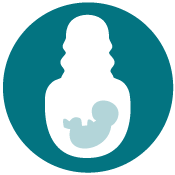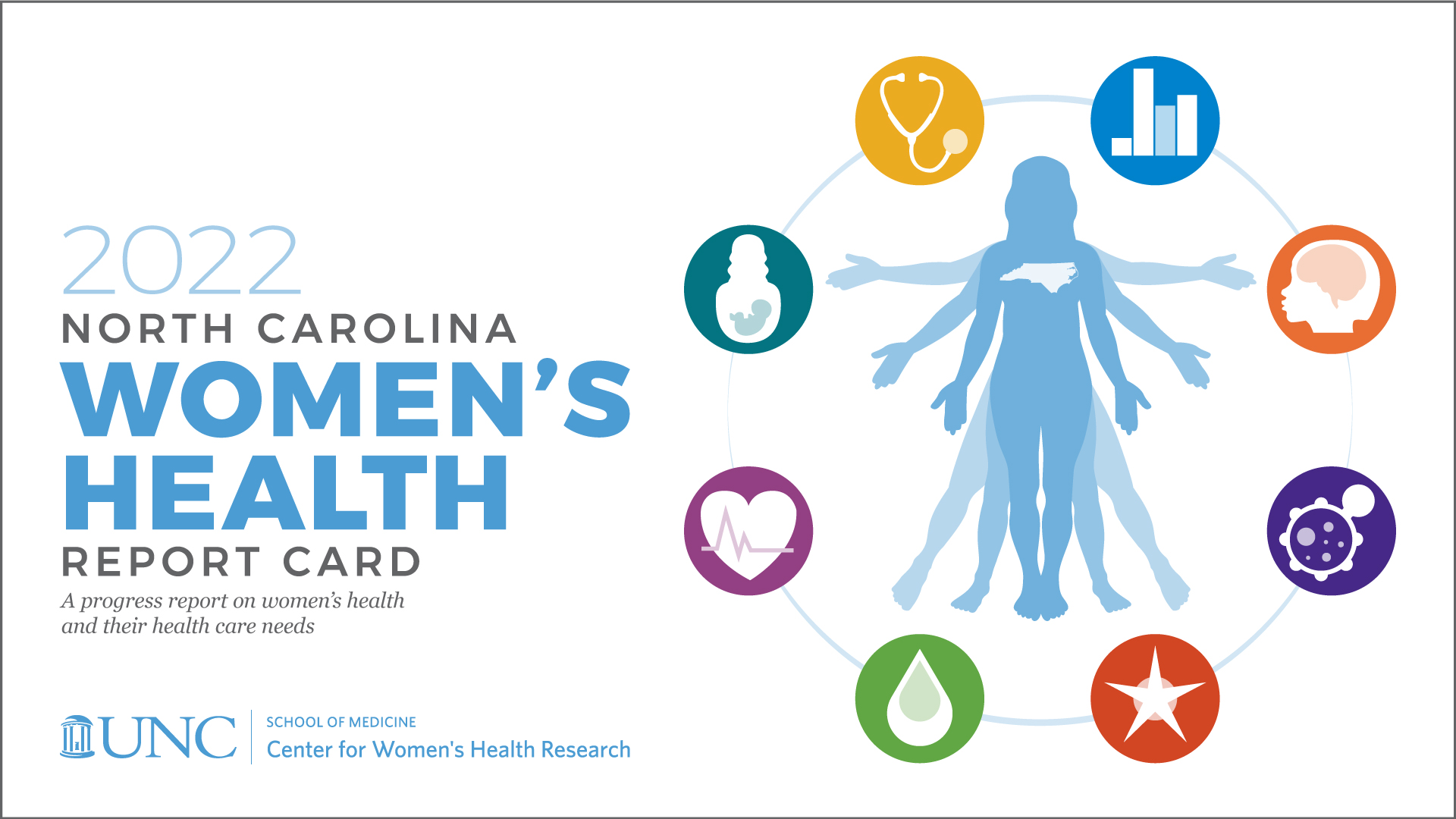2022 Women’s Health Report Card
The Center for Women’s Health Research (CWHR) released the 12th edition of our North Carolina Women’s Health Report Card on May 9, 2022. This document is a progress report on the health and health care needs of North Carolina’s 5+ million women. Research efforts that require the most attention are identified through the collection and analysis of data for the Report card. Current areas of research targeted by the Center include prevention, cancers affecting women, chronic disease (including cardiovascular health, diabetes, and obesity), women’s mental health, and substance abuse. It is the only health report of its kind in North Carolina.
Previous editions have been released biennially and tracked the state’s female health statistics in two year increments. The 2022 edition presents data from 2018-2022. Previous editions of the report card are also available for comparison. Below you can find a summary of the key observations from the report card’s advisory board as well as the full data sets utilized for each section. Healthy People 2030 is often cited as a benchmark to determine how North Carolina is hitting targets set by a consortium of agencies.
Please share on social media!
- Suggested hashtags: #ncwomen #NCWHRC #womenshealth
- Short Link to the NC Women’s Health Report Card: https://go.unc.edu/2022WHRC
Interpreting the Report Card
- The North Carolina Women’s Health Report Card uses various data sources to provide an accurate picture of women’s health in the state. Sources vary in collection methods, frequency, and sample size. For this reason, the 2022 Report Card data range mostly from 2018-2022. The year for data is indicated by the number beneath each section heading with any exceptions noted along with the data.
- Unless otherwise indicated, all data are for women ages 18 years or older. Due to limitations in data reporting, all instances of “Women” in this publication refer to those assigned female at birth.
- For all “NC Women Rankings” segments, a lower number indicates a positive trend.
- “Years of Potential Life Lost” is the difference between life expectancy and death age.
- Due to rounding, not all percentage breakdowns will combine to exactly 100%.
- There are advantages to showing data by race and ethnicity for targeting resources and interventions toward populations in need. Factors such as income, education, health care access, and where we live are known direct and indirect determinants of health outcomes and vary by racial and ethnic status. Few sources of health data record socioeconomic variables, though most collect information on race and ethnicity.
- To maintain clarity, language used for race and ethnicity data has not been changed from how it was originally recorded/reported with the exception that, for consistency, all data reported as Black and/or African American is presented here as “Black/AA.” For data in which ethnicity is considered, Non-Hispanic is denoted by “NH” in superscript. “American Indian” includes Alaska Native; “Asian” includes Pacific Islander.
 Demographics
Demographics
- The state’s woman population is steadily growing and women are projected to continue to outnumber men through at least 2030. 50% of NC women live in the 12 most populous counties; 50% live in the remaining 88.
- Orange and Transylvania Counties have the highest average life expectancy for women of 84.3 years; Swain County has the lowest of 74.1 years—a 10 year gap.
- Overall, the median age is increasing, particularly among Non-Hispanic White women with an average age of 43.8. Hispanic and Non-Hispanic Other women in NC have an average age of 27.8 and 25 respectively, representing the youngest segments of the population.
- Data sources
 Preventative Health
Preventative Health
- Women 50-74 who reported receiving, within the recommended time interval, a mammogram or recommended colorectal cancer screening are exceeding the Healthy People 2030 targets.
- Healthy People 2030 has a goal to increase the proportion of adolescents who receive the recommended doses of the HPV vaccine to 80%.
- Data Sources
 Perinatal Health
Perinatal Health
- While the 2015-2019 average number of NC women who reported smoking during pregnancy is about 9%, the highest rates were in Graham (27%) and Mitchell (24%) Counties, with a total of 15 counties reporting above double the state’s average. The lowest rates were in Wake (2%) and Mecklenburg (3%) Counties.
- Overall, fewer NC babies are born preterm (less than 37 weeks gestational age) than the Healthy People 2030 target of 9.4%.
- Black or African American women are more likely than other women to experience preterm birth and have babies with a lower birth weight. Preterm birth and low birth weight can have lifelong implications for the health and well-being of families.
- Data sources
 Chronic Disease
Chronic Disease
- After age 65, over half of North Carolina women are living with two or more chronic diseases. Chronic disease has a negative impact on the overall physical, mental, and financial well-being of women. Those with one chronic disease are at a higher risk of developing other chronic diseases.
- Heart disease is the number one killer of women. While it is a serious concern for women of all ages, rates of heart disease increase dramatically between age groups 55-64, 65-74, and 75+. Women should strive to maintain a healthy weight and diet while engaging in exercise—and refrain from smoking—to decrease their risk of heart disease.
- Diseases of the heart account for 20% of deaths (117,393 years of potential life lost annually), cerebrovascular diseases account for 6% of deaths (34,487 years of potential life lost annually), and chronic lower respiratory diseases account for 6% of deaths (41,329 years potential life lost annually).
- 65% of NC women are overweight or obese. Obesity plays an important role in the risk factors for chronic diseases such as diabetes, cardiovascular disease, arthritis, and stroke. Particular attention to lifestyle factors such as diet and physical activity have been shown to have a positive impact on weight data.
- Black or African American women are 70% more likely than White women to meet criteria for obesity. This is undoubtedly a major contributor to the finding that 45% of the state’s Black/AA women have been diagnosed with high blood pressure. It also reflects their increased risk for metabolic disorders, such as diabetes.
- Diabetes mellitus accounts for 3% of deaths (23,435 years of potential life lost annually).
- Data sources
 Mental Health & Substance Use Disorders
Mental Health & Substance Use Disorders
- One in four NC women has been diagnosed with a depressive disorder and, unlike other chronic conditions, the rate of depression does not increase with age. So, even among young women, almost a quarter have suffered from some form of depression. Stressful life events contribute to both mental and physical illness. Assessing current stressful events as part of a clinical history may improve the clinical care and outcomes for women in NC and beyond.
- A quarter of NC women reported three or more adverse childhood experiences—this should be an area to highlight for intervention efforts. Childhood adversity is a major contributor to depression in later life.
- Data Sources
 Cancer
Cancer
- Effective strategies exist to combat the four most prevalent cancers among the state’s women, including education on lifestyle, activities, HPV vaccination, and screenings for breast, colorectal, and cervical cancer. See the Preventative Health section for data on preventative screenings.
- Although the incidence rates are nearly identical, Non-White women are almost 50% more likely to die of breast cancer than White women and twice as likely to die of cervical or uterine cancer.
- Cancer accounts for 20% of deaths (161,499 years of potential life lost annually). Breast cancer alone accounts for 3% (26,201 years of potential life lost annually).
- Data sources
 Infectious Disease
Infectious Disease
- Note from the North Carolina Department of Health and Human Services: 2020 data should be treated with caution due to reduced availability of testing caused by the COVID-19 pandemic.
- Black or African American women are much more likely to have been tested for HIV than White women.
- North Carolina’s COVID-19 case rate is ranked solidly in the median—25th highest in the country.
- Data sources
 Emerging Issues
Emerging Issues
- Nearly 20% of NC women live in poverty with an additional 10% near poverty—a trend that has remained constant over the past 10 years. Consistent with national data, NC women of color are more likely to live in poverty.
- Women make up 38% of the state’s homeless population. Overall, homelessness has decreased 10% since 2010.
- The average age of women in the state is steadily increasing. 25% of NC women are over the age of 60—a 6% increase over the past 15 years, and that number is expected to grow another 3% by 2030.
- Alzheimer’s Disease accounts for 7% of deaths (28,617 years of potential life lost annually).
- Data sources
- Health Indicators – Chronic Disease
- Health Indicators – Falls and Poor Health
- Sociodemographic Data – Barriers to Care
- Sociodemographic Data – Education
- Sociodemographic Data – Health Insurance
- Sociodemographic Data – Nursing Homes
- County Data – Health Insurance
- Department of Public Safety Research and Planning
- NC Coalition to End Homelessness
- Kaiser Family Foundation – Opioid Overdose Deaths
Overall Data Sources
The following data sources were used in various sections throughout the 2022 NC Women’s Health Report Card.
Carolina Demography
CWHR utilized Carolina Demography—a service of the Carolina Population Center at UNC-Chapel Hill that focuses on population change—to collect the data found within this report. They provide a full array of demographic services for North Carolina businesses, foundations, government agencies, schools, not-for-profit organizations, and more. Learn more at their website, ncdemography.org.
Data Sources
America’s Health Rankings; American Community Survey Data (1-year samples from IPUMS-USA); Behavioral Risk Factor Surveillance System (BRFSS); Carolina Demography; Healthy People 2030; NC Central Cancer Registry; NC 2020 HIV/STD Surveillance Report; NC Department of Health and Human Services; NC Department of Public Safety; NC Office of State Budget and Management Population, Census, Economic, and Social Statistics Publications; Pregnancy Risk Assessment Monitoring System (PRAMS)
Acknowledgements
The following UNC-Chapel Hill faculty and staff were integral to the completion of this report card:
2022 NC Women’s Health Report Card Advisory Committee
Bianca Allison, MD, MPH
Assistant Professor of General Pediatrics and Adolescent Medicine, Department of Pediatrics, School of Medicine
Victoria Bae-Jump, MD, PhD
Professor of Gynecologic Oncology, Department of Obstetrics & Gynecology, School of Medicine
Jessica Bowser, PhD
Assistant Professor, Department of Pathology and Lab Medicine, School of Medicine
Leigh Callahan, PhD
Distinguished Professor of Medicine, Department of Medicine, School of Medicine; Associate Director, Thurston Arthritis Research Center
Hendrée Jones, PhD
Professor, Department of Obstetrics & Gynecology, School of Medicine; Executive and Division Director, UNC Horizons Program
Andrea Knittel, MD, PhD, FACOG
Assistant Professor of General Obstetrics & Gynecology and Medical Director for Incarcerated Women’s Health, Department of Obstetrics & Gynecology, School of Medicine
Samantha Meltzer-Brody, MD, MPH
Distinguished Professor and Chair, Department of Psychiatry, School of Medicine; Director, UNC Center for Women’s Mood Disorders
Michelle Meyer, MD, MPH
Associate Professor and Associate Chair of Research, Department of Emergency Medicine, School of Medicine
Paula Miller, MD
Professor of Medicine, Director for Cardiac Rehabilitation, and Director for Women’s Heart Program, Department of Medicine, School of Medicine
Hazel Nichols, PhD
Associate Professor, Department of Epidemiology, Gillings School of Public Health
Abbie Smith-Ryan, PhD, CSCS*D, FNSCA, FACSM, FISSN
Associate Professor of Exercise Physiology, Department of Exercise and Sport Science, College of Arts and Sciences; Director, Applied Physiology Laboratory; Co-Director, Human Performance Center
Elizabeth Stringer, MD, MSc
Professor of Maternal-Fetal Medicine, Department of Obstetrics & Gynecology, School of Medicine
Catherine Sullivan, MPH, RDN, LDN, IBCLE, RLC, FAND
Assistant Professor, Department of Maternal and Child Health, Gillings School of Public Health; Director, Carolina Global Breastfeeding Institute
Carolina Population Center
Joanne Brosh, PhD
Research Analyst
Elliot Kent, PhD
Project Manager
Rebecca Tippett, PhD
Director
Center for Women’s Health Research
Wendy R. Brewster, MD, PhD
Director
Michael Kerr
Public Communications Officer

